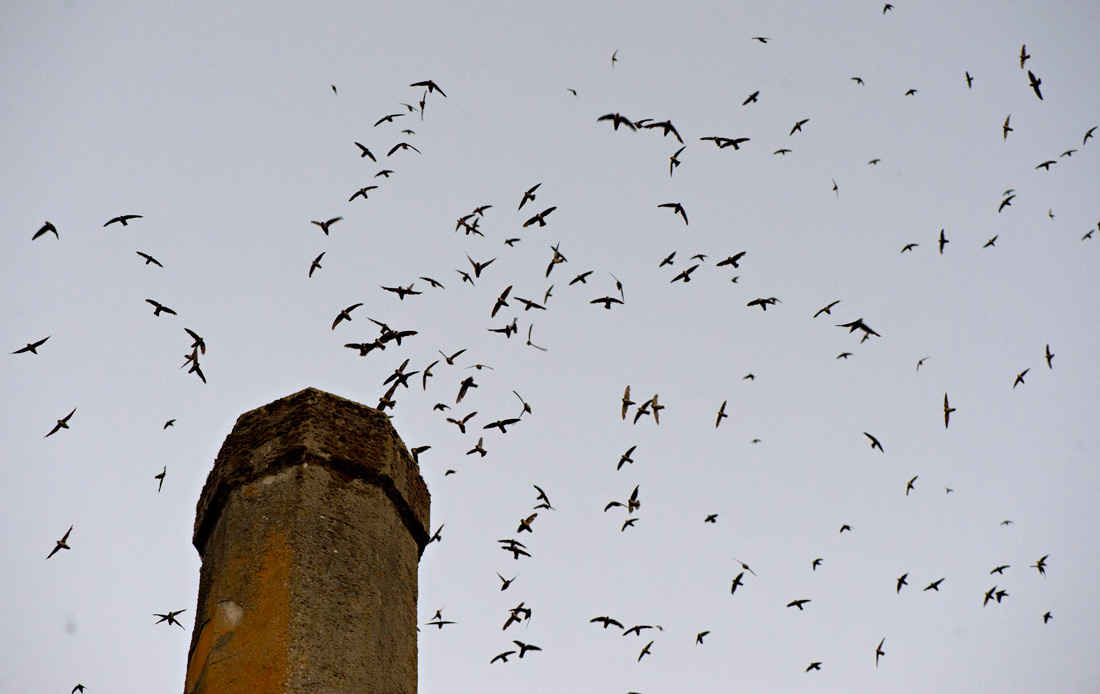Mary Anne Schoenhardt, Ontario Chimney Swift Research Specialist
If birds nest in nuclear power facilities, do they get super powers? Not quite, but seeing over 2500 Chimney Swifts roosting in the chimney of a decommissioned nuclear reactor sure is super!
Prior to European colonization, Chimney Swifts nested and roosted in the trunks of large, hollow trees and caves; however, this habitat is now scarce, and since the 18th century, they have primarily used chimneys. As aerial insectivores, Chimney Swifts spend their days in flight, catching insects to eat. Overnight, they congregate and roost in chimneys, which provide them shelter from the elements, and a rough, vertical surface they require for perching. When the breeding season begins, groups of two or three Chimney Swifts will go off and find their own chimney, in which they build a nest and raise their young.
In Canada, Chimney Swifts have declined by almost 90% since 1970 and are listed as Threatened on the Species at Risk Act. Their population declines are thought to be the result of both declining insect populations and loss of habitat that Chimney Swift require for nesting, roosting, and feeding. As a conservation effort, a number of groups have built artificial towers that mimic chimneys; however, these have been largely unused by Chimney Swifts in Canada.

Chimney Swifts. Photo: Robin Loznak
One of the largest concentrations of Chimney Swifts in Canada can be found in Rolphton, Ontario, at the partially decommissioned Nuclear Power Demonstration (NPD) site. Since 2010, biologists with the Canadian Nuclear Laboratories (CNL) have performed yearly counts of Chimney Swifts entering the ventilation stack, or chimney, of the historic reactor. The ventilation stack is used as a roost site for Chimney Swift, where over 2500 individuals have been recorded!
The NPD reactor was Canada’s first nuclear power reactor. Used from 1962 until 1987, it was crucial for the training of future reactor operators and engineers, and was the forerunner to the currently used CANDU Reactor. The NPD reactor itself is a small prototype reactor built down into the bedrock. CNL is proposing to complete decommissioning via in situ disposal, which involves filling remaining empty systems and the underground structure with grout sealing material, where it will remain contained and safe.

Chimney Swift. Photo: Andres Jimenez
The above ground part of the NPD facility poses no threat to humans, and would be safely dismantled prior to the grouting. But what about the large population of Chimney Swifts that use the ventilation stack each spring and summer? After discussion with a large number of groups, including Birds Canada’s Ontario SwiftWatch team, CNL made the decision not to demolish the ventilation stack and keep it solely for its purpose as Chimney Swift habitat!
This is a huge success for the conservation of Chimney Swifts, and we applaud CNL for making the decision to retain the ventilation stack as they finish the process of decommissioning the rest of the site. We look forward to further partnership with CNL as we work to conserve Chimney Swifts in Canada!
Conservation doesn’t need to happen in only the remote corners of our country, but in our cities, our parks, and our backyards. If you want to learn more about the conservation initiatives that Birds Canada is pursuing for Chimney Swifts, or are interested in monitoring sites in Ontario or the Maritimes, visit https://www.birdscanada.org/bird-science/swiftwatch to read about Birds Canada’s SwiftWatch program. And, to learn more about the NPD site including seeing thermal imagery of swifts entering the stack, visit the CNL website.
